How To Soundproof A Door – Complete Guide
The most effective way of soundproofing a door is to apply soundproofing rubber to the door perimeter or use weatherstripping. Other methods involve installing a door gasket, acoustic panels or solid core doors to absorb sound waves effectively. When compared to old houses, modern-day apartments are noisier due to faulty construction, open floor designs, and […]
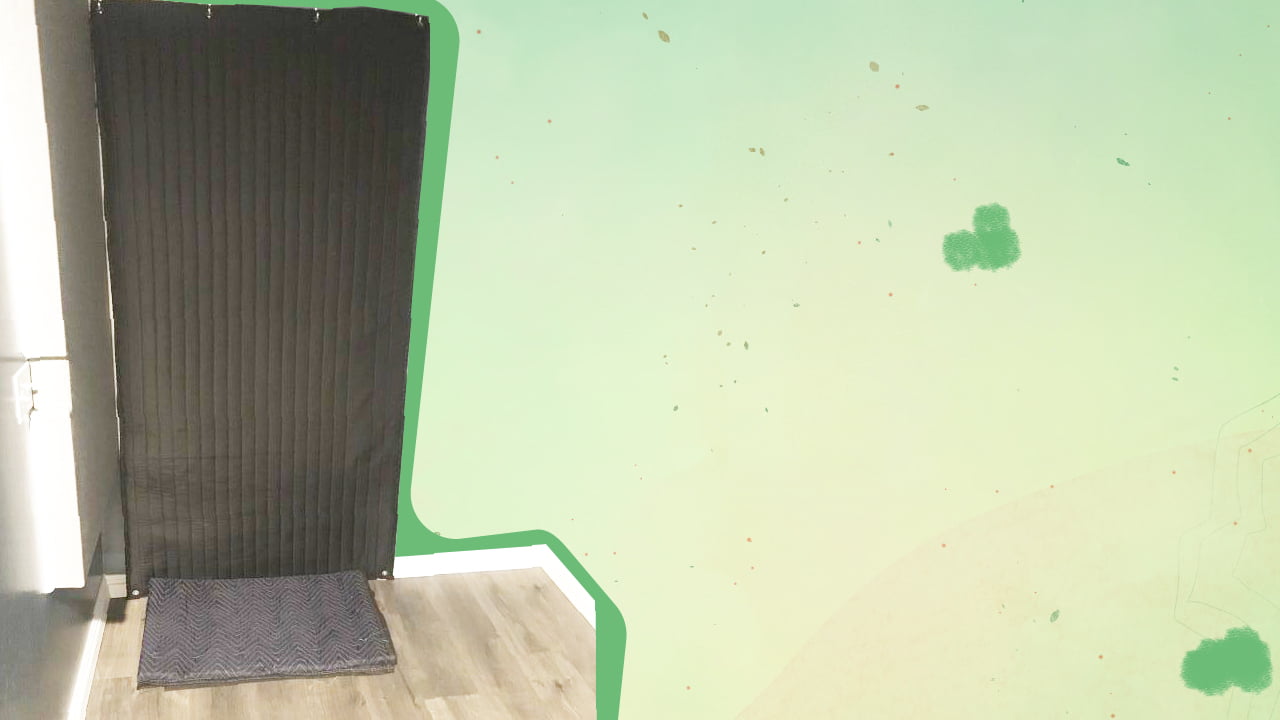
The most effective way of soundproofing a door is to apply soundproofing rubber to the door perimeter or use weatherstripping. Other methods involve installing a door gasket, acoustic panels or solid core doors to absorb sound waves effectively.
When compared to old houses, modern-day apartments are noisier due to faulty construction, open floor designs, and extensive use of entertainment devices. These make soundproofing a necessity in many situations, such as if you have neighbors who create a ruckus or when working from home.
In such cases, soundproofing the door should be the priority since it is the main entrance to the house. So, my guide explains the most effective methods to accomplish that.
How To Soundproof A Door
Best Door Noise Reduction Techniques
1. Installing A Door Gasket
When sound travels through gaps, it gets amplified. Such gaps are usually present around the door frame, which can be blocked using a door gasket. A door gasket is generally made from high-quality neoprene and attaches easily to the top and sides of the door jamb, effectively blocking out sound.
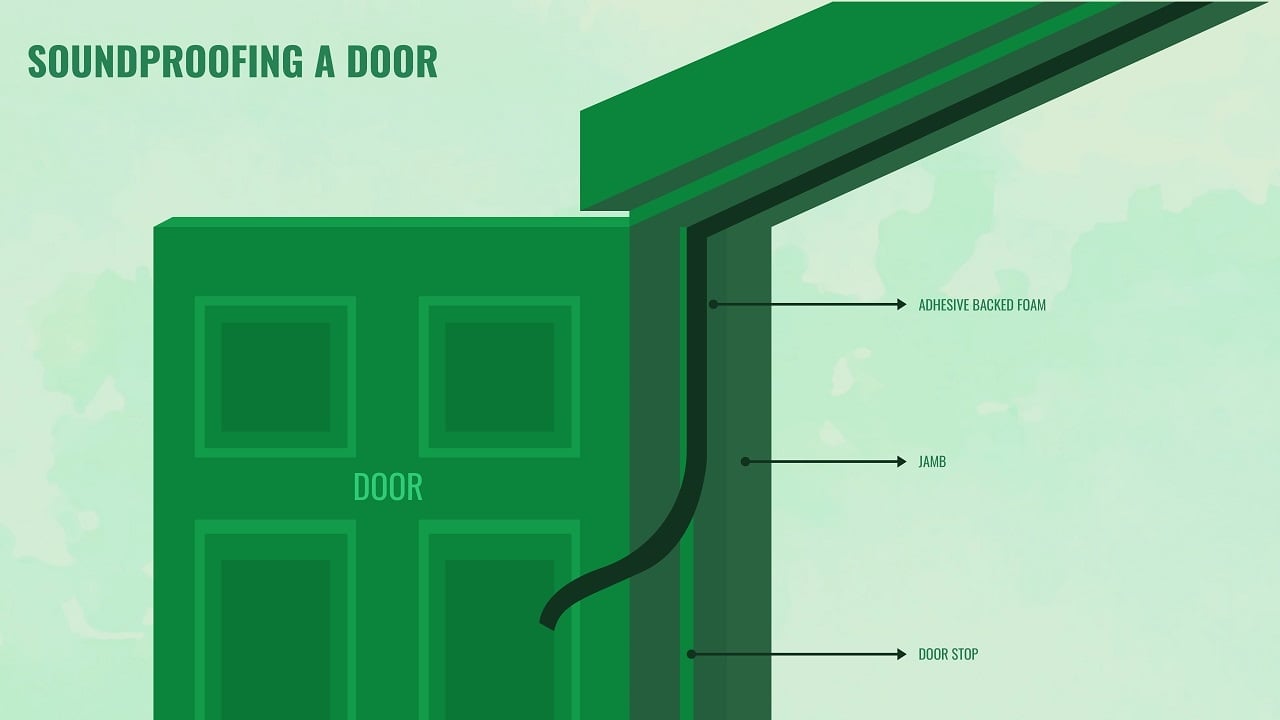
You can find many types of door gaskets on the market to soundproof your door, even vinyl and adjustable ones. These also block moisture, dust, and light and can be used on doors that may not be rectangular or are warped.
2. Applying Soundproofing Materials To The Door Perimeter
Another excellent method you can try is to apply soundproofing materials to the door perimeter. Such materials may be made from highly dense neoprene but will require the removal of any existing molding around the door.
Once the molding has been removed, you can apply the material around the door edges. And to make this technique more effective, apply some insulating sealant or acoustical caulk in various gaps and cracks.
3. Using Weatherstrips
Weatherstripping is one of the most common ways of soundproofing a door. This allows you to fill in the gaps between the door frame and the door through which sound enters, while ensuring the door closes tightly.
When choosing weatherstripping, you should go with higher quality options since they can last for a longer period. To install it, first clean the area properly where it has to be applied and make sure that it is completely dry.
While applying, use a lot of pressure to create an airtight seal to block sound waves. You can also nail it to the door surface, as it will even prevent the door from slamming shut.
4. Installing A Door Sweep
In many cases, the largest gap that exists between a door and the door frame is at the bottom. To block sound from entering through this gap, you can install a door sweep at the base of the door. These are usually constructed using natural rubber, silicone, or dense metal like aluminum available in various sizes.
They are also widely compatible, can be installed under exterior and interior doors, and offer additional benefits besides soundproofing. For instance, a door sweep prevents bugs and insects from entering your home from under the door. And they can help control the temperature by covering the gap from where air can enter and escape.
That being said, keep in mind that installing a door sweep is not very simple. The reason is that most door sweeps have to be installed by drilling screws into the door, so you will need a drill, screws, and a screwdriver.
But finding a door sweep that is the perfect size for your door can take some time. Hence, getting an automatic door sweep is another option you can consider.
5. Getting A Solid Core Door
If you are willing to invest in long-term soundproofing techniques, then getting a solid core door might be the best option. A hollow core door is made using thin wooden sheets and tends to wobble, which is not the case with solid ones. Most interior doors have a hollow core, while exterior ones have a solid core.
You can get a metallic door or solid wood doors that absorb sound more effectively. Remember that wooden doors tend to dampen sound rather than block it completely, while metallic ones can reflect the sound waves back.
6. Applying Mass Loading Vinyl
Vinyl sheets provide additional mass to the door and help prevent sound waves from traveling through. Applying such sheets is also easy; you can get one or more heavy vinyl sheets and cut them to match the door size. These can then be applied to the door using sound-dampening glue or pressure-sensitive adhesive strips.
Alternatively, mass-loaded vinyl sheets can even be installed within the core of the door.
For best results, cover as much surface of the door as possible with the sheet, and you can even apply a double layer, though it can cost more money. These panels are usually available in thicknesses ranging from 1/16 to ¼ inch.
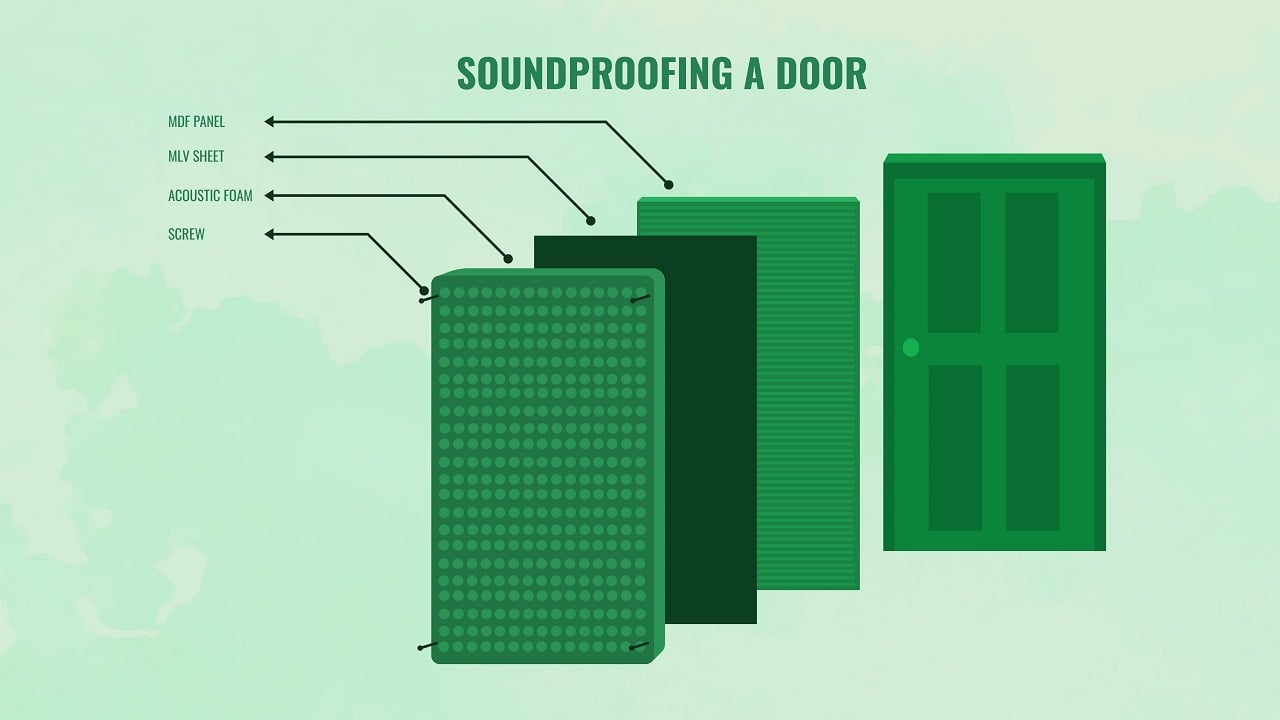
7. Installing Acoustic Panels
If you’re looking to soundproof your door without spending a lot, installing acoustic panels might be the perfect solution. Acoustic or soundproof panels are made from very dense foam or polyvinyl chloride, which provides greater air resistance. When sound waves hit these surfaces, they tend to bounce back rather than travel through.
The biggest advantage of such panels is that they do not cost as much as more expensive soundproofing solutions, like fiberglass soundproofing blankets, and can be used with drywall. Also, acoustic panels are made from many different materials, like wood and foam, and can even be used on the ceiling.
You can use adhesive strips to install soundproofing panels, but some people prefer splitting open the door and installing these panels within. But this is a very complicated process, and it might just be easier to get a customized door with such panels already installed.
8. Filling Cracks Using Gap Foam
Foam sealants are available for filling cracks and gaps in doors through which sound waves travel. These sealants expand as the foam grows, creating an effective barrier against vibration.
However, these tend to be most effective when a highly dense sealant is used since it has a good sound transmission class. In other words, the denser the foam, the better the result.
Gap foam is usually applied in the form of a spray, which should be sprayed from the inside before moving toward the outside of the door. Also, it is a good idea to apply the foam to door knobs that are hollow since these have holes that go right through.
Generally, gap foam is applied after other soundproofing methods have been used, such as acoustic panels and door sweeps. Or you can attach foam flooring tiles to the door using Velcro pads.
9. Using A Soundproof Blanket
Soundproofing blankets are usually made from fiberglass, a material that is excellent for absorbing sound. These are quite easy to install and can be placed or removed on top of the door as needed, but prove quite expensive.
An alternative to a costly soundproof blanket is a moving blanket, which is a textile made using durable fabric. But this usually lacks grommets for attaching and may not be available in the appropriate size. Also, such a blanket can affect the appearance of your door, so it might be ideal for an interior door that is usually hidden.
A soundproof blanket is best for places like a recording studio due to its excellent sound absorption capability. To install a soundproofing blanket, place suction cups on the back of the door from which the blanket can be hung.
10. Installing Soundproofing Composite Material
Composite soundproofing material consists of a noise barrier and a sound absorption material for use inside, outside, or under the door. Such material is available in the form of thick sheets that are quite heavy and can prevent sound transmission through the door.
The composite material can be screwed or glued onto the surface of the door. Soundproofing composite material can also be used as a mat under the door, but when used like that, it should cover the gap between the door and the floor.
Alternatively, you can use a custom-made door that has composite material within it.
11. Applying A Fiberboard
Fiberboards are similar to composite materials since they can be used on the outside and inside of the door. The difference between the two is that composite material is much more malleable and can be bent easily.
To install it, open the door and insert a fiberboard within to ensure proper sound insulation. You can place the fiberboard inside, outside, and around the sides of the door handle and frame to fill in cracks or gaps.
Keep in mind that a denser board will be better for soundproofing than thin ones, like plywood.
12. Using Sound Isolation Padding Tape
You can use sound isolation padding tape, which can create an airtight seal around the door and even serve as an alternative sound barrier similar to door gaskets and weatherstripping. Using sound isolation padding tape is also among the most cost-effective ways if you want to ensure complete silence.
Padding tape is generally used to install wallboards and is self-adhesive. So, it can be applied easily and even be used on windows as a temporary noise reduction measure until you decide on a permanent solution.
13. Getting A Soundproofing Kit
If getting individual soundproofing materials like panels and blankets sound too complex, you can get a premade soundproofing kit. Such kits include all the necessary items required for noise control, such as acoustic panels, door sweeps, weatherstripping, composite material, fiberboard, etc., and are easily available in the United States.
A soundproofing kit usually comes with items like water-based caulk, which can be used to fill up cracks and holes around the door. To do so, apply a bead of caulk into the crack while wiping away excess amounts using a utility knife. Similarly, in case the door has glass installations, you can use silicone to block sound.
14. Using Sound Absorbers
Another way of making a door soundproof is to absorb sound coming from the other side of the door. This is because the level of sound that a door can block will depend on the sound coming from the other side.
Many items usually present in a room can help reduce noise, such as wall pictures, floor rugs, furniture, and more. If the room on the other side of the door does not have many sound absorbers, more sound will reach the door and pass through it.
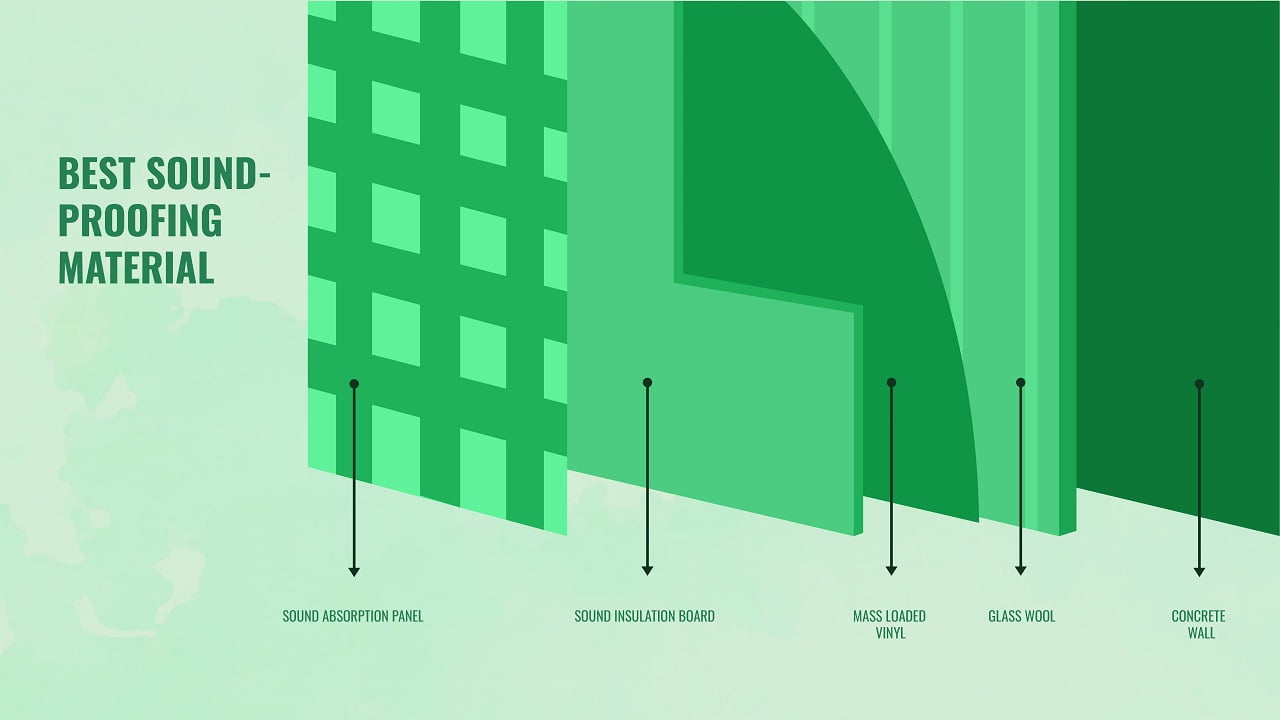
So, consider adding more furniture or items like rugs to the room on the other side of the door. This will reduce the need for soundproofing the door significantly. You can get an area rug or mat that can prevent sound from bouncing off the floor and creating echoes. Similarly, placing paintings on the walls will make the room much quieter.
15. Installing Meeting Stiles
In rooms with double doors, it may not be possible to soundproof them completely. For that, you can use meeting stiles which ensure a tight seal between the doors when they close. Meeting stiles may be made from various materials, such as composite material and rubber.
Installing meeting stiles is not a very complex process and doesn’t take much time. You just need to select the right-sized stile and screw it in place using bolts to check whether the doors shut tightly.
16. Using Acoustic Door Thresholds
Using an acoustic door threshold is another method you can try if you’re wondering how to soundproof a door. Such thresholds are generally made of neoprene and have rubber protrusions that prevent sound from passing through gaps between the door and frame. However, they have to be attached to the floor instead of the bottom of the door, unlike door sweeps.
This allows the door to be opened or closed without the sweep being dragged across the floor, which can itself become a source of noise. An acoustic threshold is often essential in rooms where the floor is carpeted since door sweeps are not very effective with a carpet.
Thresholds may be available in a flat shape or have an upward-facing extension to create a double seal when used with a door sweep. Here, I’d like to mention that apart from soundproofing door thresholds, it’s important to ensure that all perimeter gaps are sealed properly. Even a small gap can reduce the efficacy of a soundproof door.
17. Applying Soundproof Paint
Few people are aware that you can use soundproofing paint on doors for noise reduction. The reason is that such paints can only block mid-range audio frequencies, such as the sound of people talking. So, higher frequency acoustics, such as that of a flute or a phonograph record, or low-frequency sounds like that of traffic will not be reduced.
Soundproof paint is most effective when used on a large, flat surface but it can make the surface texture uneven. That is why you will need to apply multiple coats to make the coat a bit thick.
But this is an excellent alternative if you’re looking for an inexpensive method to make any space quiet. Just make sure to use other soundproofing methods along with it to get the desired results.
18. Filling The Door With Sand
You can use this method to soundproof a hollow door, but it is extremely complicated and will require a lot of preparation. The door will first have to be cut using a hacksaw so its interior can be filled with sand and sealed properly.
Also, to attach the door back, you will require industrial-strength door hinges since normal ones can be pulled right out due to the weight of the sand-filled door. An industrial-strength hinge will remain connected to the door jamb and support even the heaviest doors.
Once the door is reattached, it will be able to block out all sound completely since the sand will act as a sponge for maximum absorption.
19. Installing A Door Seal Kit
An acoustic door seal kit is an excellent solution for people who want to soundproof a door but have a limited budget. Such kits are used to seal the air gaps around a solid core door and are excellent for noise reduction purposes.
While it is possible to use a door seal kit on hollow doors, it is most useful when used with solid-core ones. When using such a kit on a hollow door, combine it with a soundproof curtain or blanket to enhance its soundproofing ability.
20. With A Soundproofing Curtain
You can use a soundproofing curtain to reduce the noise that passes through a door, but it is not an easy solution. This is because curtains hang in front of the door, with the sides left open, providing gaps through which sound can travel.
That is why when using a soundproofing curtain, you should try to attach them in a manner that creates a tight seal around the door. You can even sew different sides of the curtain to make it thicker but make sure it covers the entire length and width of the door.
Soundproof curtains are generally more affordable than soundproof blankets and serve as great temporary solutions for noise control.
Tip
If you’re looking for a temporary, tool-free solution without wanting to spend anything, use household items to soundproof a door. For instance, the gap at the bottom of the door can be stuffed with rags or towels to prevent noise from filtering through.

The Importance Of Soundproofing Your Door
Since doorways are the largest opening in a room, they are responsible for allowing maximum noise to pass through. This means any soundproofing treatment should make them the priority, so here are a few reasons why soundproofing the door is crucial.
1. Doors Always Allow Sound To Travel Through
Even when a door remains shut, the gaps around it, especially at the bottom, allow noise to leak through. In addition, most interior doors are hollow from the inside, so they do not offer any obstruction to sound waves. Due to these reasons, doors allow more sound inside a room than any other opening.
2. Soundproofing Can Also Provide Temperature Insulation
Many soundproofing materials provide excellent temperature insulation and keep the room temperature at the required level. This happens because these materials prevent air from passing through them, so you don’t have to experience extreme temperatures. And because of this, the thermostat will require less energy and time to make the room cooler or warmer.
3. For Privacy
Soundproofing the door can ensure proper noise control and privacy, preventing others from hearing what is going on inside your home. Alternatively, it can reduce disturbances in various rooms, especially important if you are planning to create a home music studio or have pesky neighbors who like to eavesdrop.
4. To Improve The Value Of The House
Whether you’re planning to sell your house in the future or making renovations and repairs for the long term, soundproofing can help. People will generally pay more for a house that has soundproofed rooms, and such houses are perfect for selling to music production studios.
5. For Fire And Smoke Protection
Soundproofing a door is also essential for protection against smoke and fire. Since door soundproofing essentially involves closing all gaps around a door, the same can be effective in blocking smoke and flames from getting in.
Things To Keep In Mind When Soundproofing A Door
Before you start soundproofing your doors, here are a few things to keep in mind.
1. Begin With The Most Affordable Solution
You can find soundproofing solutions at different price points, ranging from budget options to extremely costly ones. But not every solution is perfect for each home. So, it is a good idea to go with the most affordable option in the beginning before moving on to high-end solutions if that does not work.
Starting small will also offer the advantage that it will likely not require much time and effort. Plus, these are good techniques for people who do not want to make a lot of changes to the door, floor, or surrounding spaces.
2. Find Out Where The Noise Is Coming From
The type of soundproofing treatment which will be most effective will depend on where the sound is coming from. For instance, if the noise is coming from outside, the front and back doors will require more intensive treatment than the interior ones.
Similarly, if you have a noisy neighbor, you may require an effective soundproofing treatment for the door of the room.
3. Hire A Professional If You Find The Project Challenging
A DIY soundproofing and home improvement project may not always be successful, but this does not mean it cannot be done. If you find the project challenging, simply hire a professional to get the job done. Plus, many professionals can complete soundproofing projects at affordable rates.
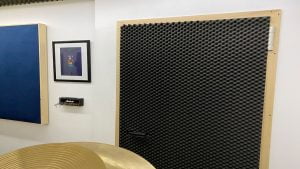
Some Soundproofing Myths You Should Know About
There are several myths surrounding soundproofing, and knowing about them can be very helpful when undertaking such a project.
1. Glue Or Paint Can Be Used For Soundproofing
Sound waves can be obstructed by materials that have high density and mass. So, materials like glue or paint, which lack these properties, are not very effective for the purpose. That said, applying multiple coats of thick paint specially developed for the purpose can help reduce sound transmission.
2. Rugs Are Very Effective For Soundproofing Purposes
Rugs can be used for absorbing sound but cannot block out noise completely. The reason is that even the thickest and largest rugs do not have enough mass to absorb all sound in the vicinity. That is why they have to be used along with other soundproofing methods.
3. Insulation, Foam Blocks, And Regular Blankets Can Be Used For Soundproofing
In this case, also, it is possible to reduce the sound but not get rid of it completely for the same reason. Generally, if you’re using such materials for soundproofing, make sure to use heavier and thicker blankets or foam blocks. They have more mass and thus are better at blocking sound.
4. Curtains Are Very Effective For Soundproofing Purposes
As explained above, curtains can help make a door insulated against sound, but they need to be installed properly for that. This means there should not be any gaps around the door or curtain through which sound can travel.
5. Egg Cartons Can Be Used To Soundproof A Door
Egg cartons can be used to reduce echoes in a room. However, they do not offer the same results when used for soundproofing a door.
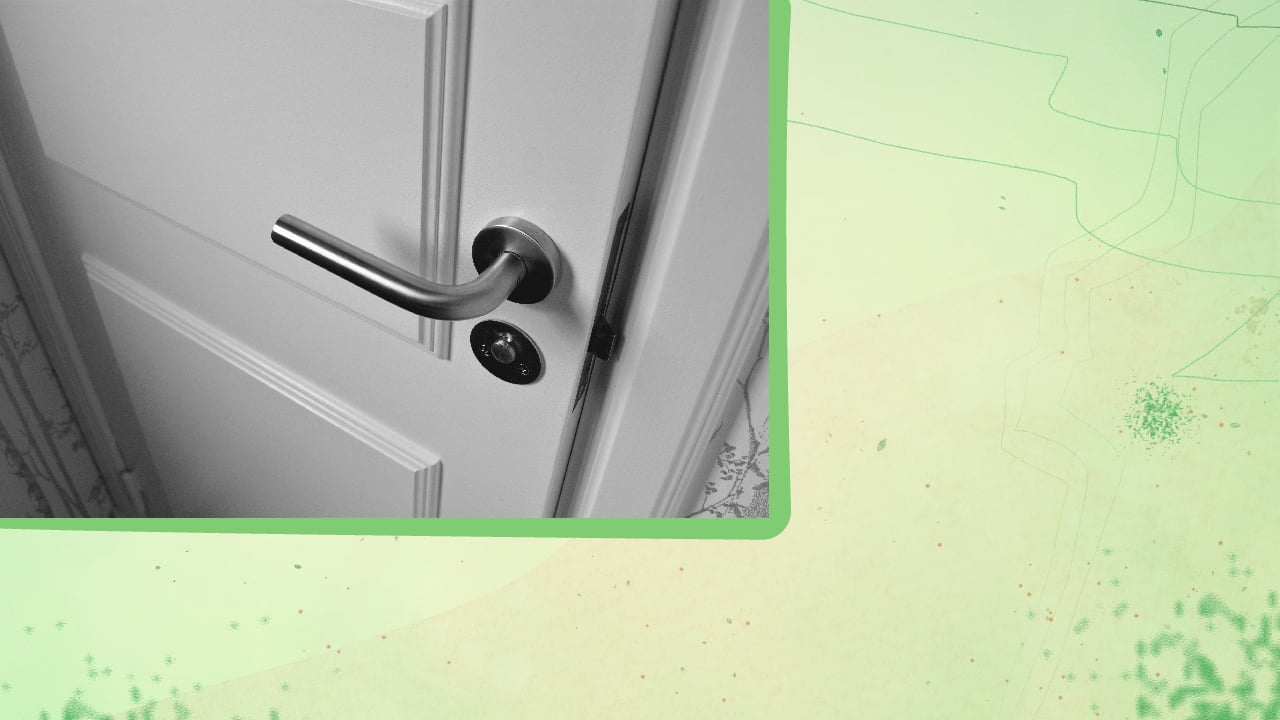
How To Soundproof A Door Final Thoughts
Soundproofing offers several benefits, such as preventing disturbances and ensuring privacy. Generally, I recommend using more than one method to get better results, especially since not all the techniques are suitable for every house.
But if you are unsure about implementing these methods, the best thing to do is call a professional soundproofing service. Such companies send soundproofing experts to your home for a detailed inspection and help complete soundproofing quickly.
